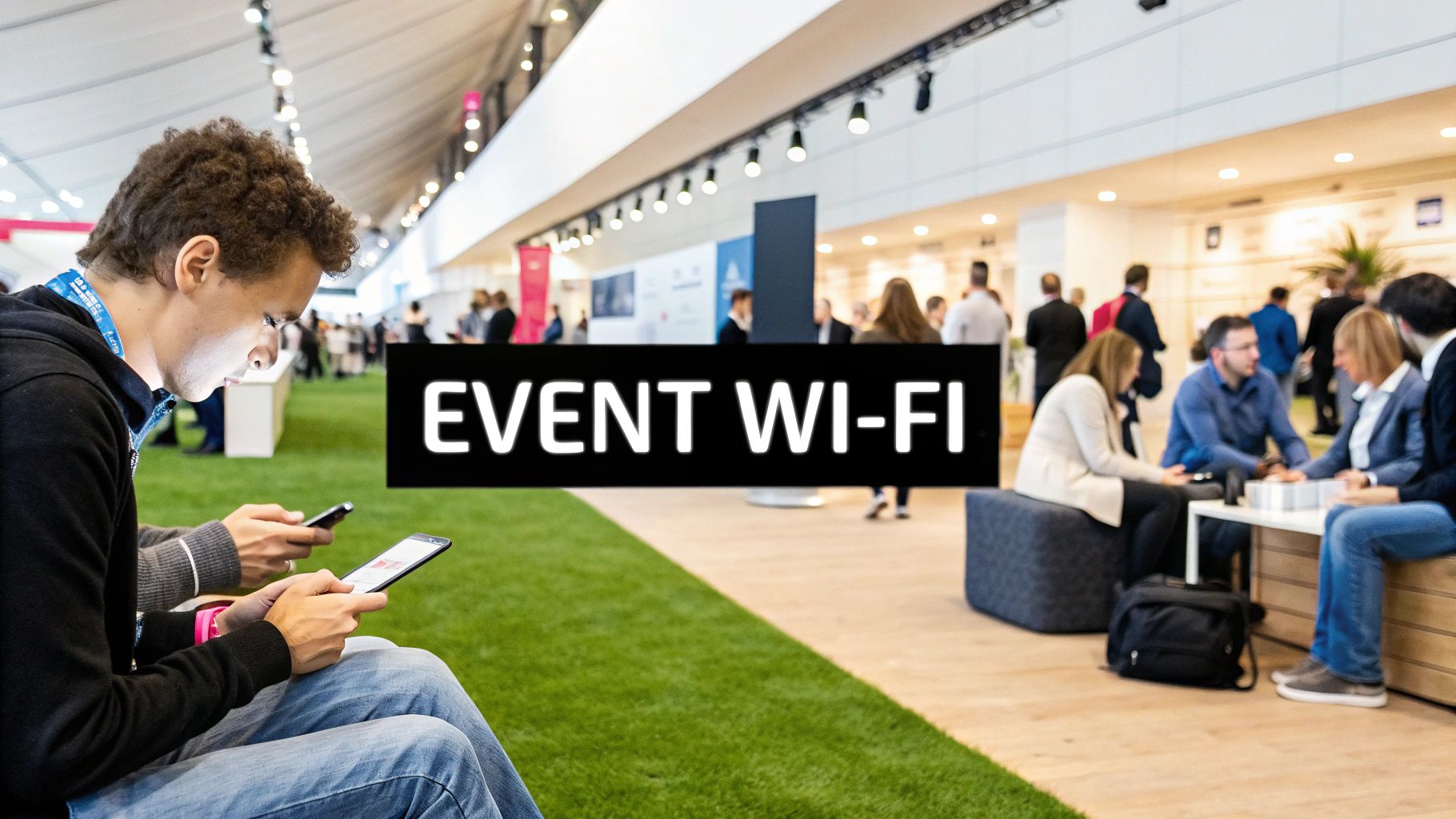Let's get one thing straight: bad Wi-Fi can absolutely tank an event. It's not just a nice-to-have anymore; it's the very backbone of modern live experiences, powering everything from live streams and social media buzz to the engagement apps in every attendee's hand. A solid event wi fi network isn't just about connectivity—it directly shapes the attendee experience, sponsor value, and the overall success of your operation.
Why Event Wi-Fi Should Be Your Top Priority
Think of reliable event wi fi as the central nervous system for your conference, trade show, or festival. It’s the invisible force that makes every digital interaction possible. When it works, nobody gives it a second thought. But when it fails? It’s the only thing anyone will remember.
A spotty connection introduces immediate frustration. Attendees can’t share their experiences on social media, exhibitors get stuck trying to process sales, and the production crew might lose the feed during a critical live broadcast. These aren't just minor hiccups; they're fundamental breakdowns that can sabotage your event's goals.
The Foundation of Modern Event Experiences
Today's events are built around digital interaction. Your attendees show up expecting to connect, share, and engage with content instantly. This deep reliance on connectivity is exactly why a dedicated event wi fi solution is so essential.
- Attendee Engagement: Interactive tools like live polls, Q&A sessions, and event apps all depend on a stable internet connection that can handle hundreds or even thousands of people at once.
- Sponsor and Exhibitor Success: Your sponsors are counting on reliable internet for their digital activations, lead capture forms, and product demos. A weak signal means lost opportunities and a poor return on their investment.
- Operational Efficiency: Behind the scenes, your own team relies on that same Wi-Fi for registration, staff communication, and even managing stage production elements.
A seamless Wi-Fi experience is no longer a perk; it's an expectation. The success of digital engagement, sponsor activations, and even basic event logistics hinges entirely on the quality of your network infrastructure.
The connection between a strong network and a successful event is direct and undeniable. Investing in a solid Wi-Fi foundation is the first real step toward achieving your bigger event goals.
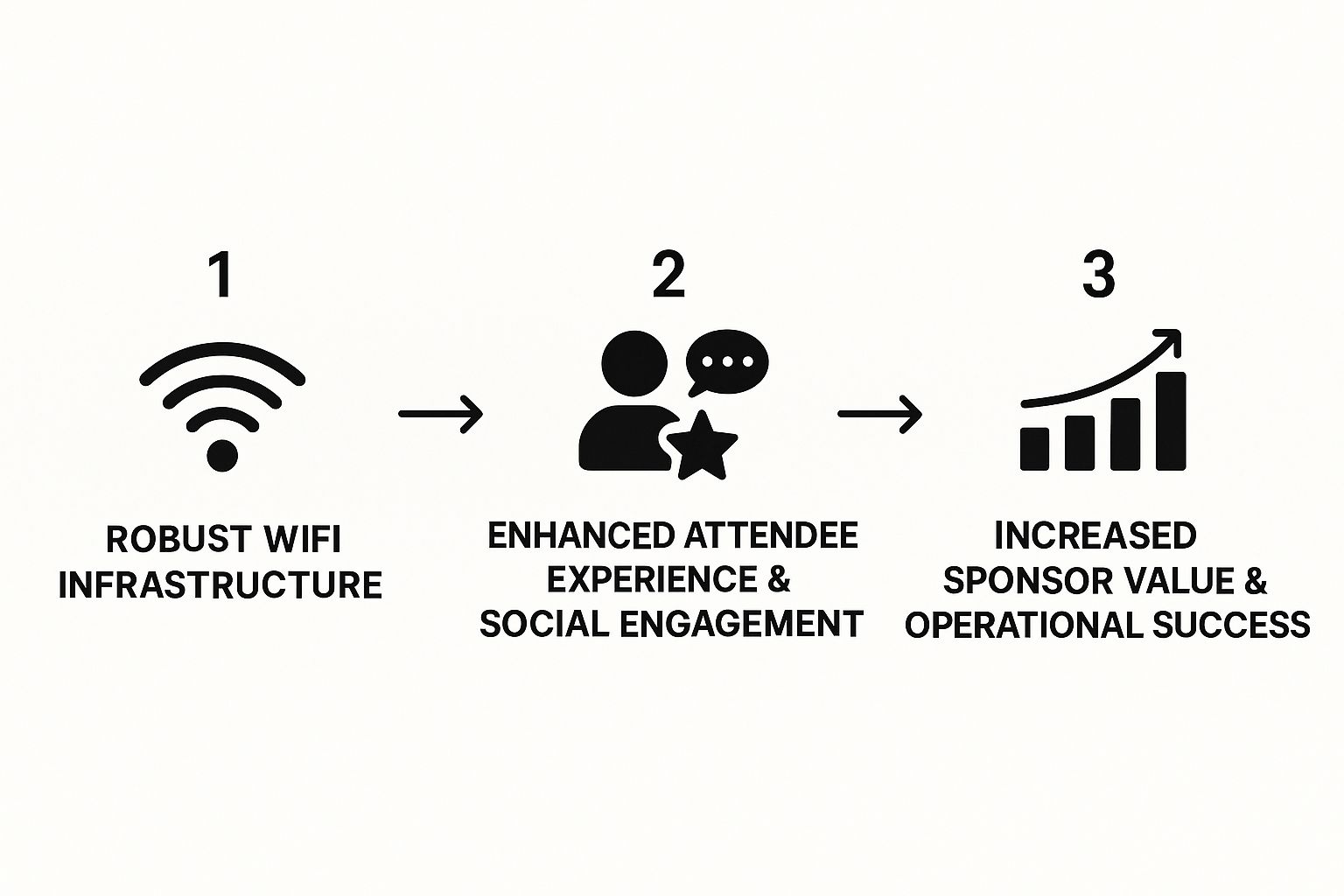
This reality is even more pronounced with the rise of hybrid events, which have to serve both a physical and a virtual audience demanding flawless connectivity. In fact, many strategies for successful hybrid event production begin with a conversation about network capacity.
The market reflects this growing demand. The event wi fi services market is on track to hit $7.45 billion by 2033, with a projected annual growth of 13.7%. This boom is fueled by new technologies designed to deliver the high-speed, reliable internet that modern events require.
Creating Your Event Wi Fi Blueprint
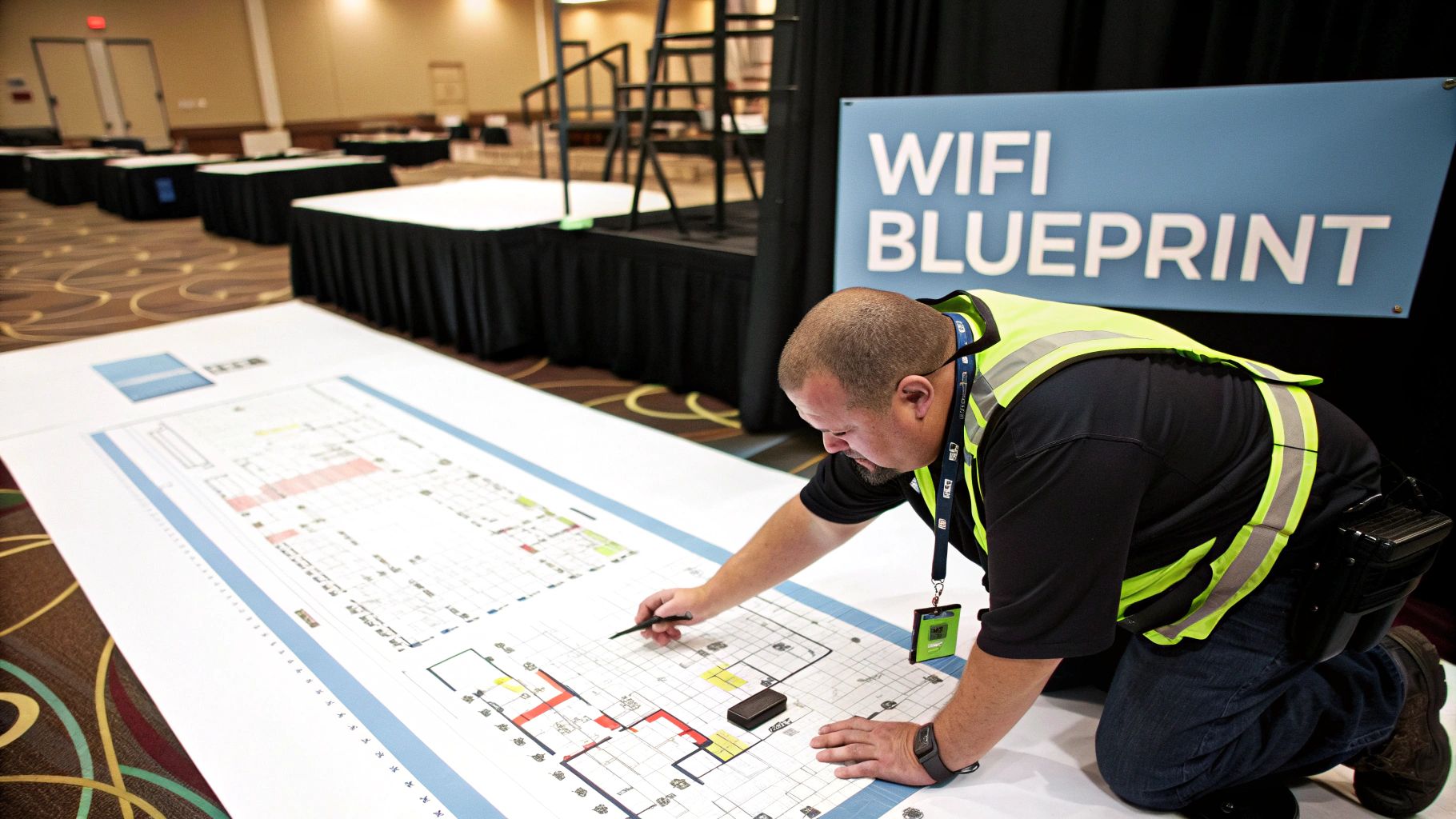
Reliable event wi fi doesn't just happen. It's the result of a solid, well-thought-out plan. Before you even think about installing equipment, you need a blueprint that nails down exactly what you need. This is the phase that separates a seamless online experience from a day filled with frustrating tech support calls.
First things first, you have to get honest about your numbers. Don't just look at ticket sales. The real magic number is concurrent users—how many people will be connected at the exact same time.
From my experience, a safe bet is to assume each person will connect at least 1.5 devices. Think about it: everyone has a smartphone, and many will also have a laptop or tablet. For a 500-person tech conference, that means you need to be ready for 750 simultaneous connections, not 500.
Defining Your Bandwidth Demands
Once you have a handle on how many people will be connected, the next question is what they'll be doing. Simple web browsing and checking emails are one thing, but live streaming a keynote or running interactive demos is a completely different animal. Your event agenda is your best friend here, as it's the key to predicting how much bandwidth you'll actually need.
You've got to pinpoint the most data-hungry activities to prevent your network from grinding to a halt. Watch out for these bandwidth hogs:
- Video Streaming: Are you broadcasting keynotes live? Do your exhibitors plan on running high-definition product demos on a loop?
- Interactive Sessions: Things like augmented reality (AR) or virtual reality (VR) experiences are amazing, but they require a massive and incredibly stable connection to work without glitches.
- Large File Transfers: If you've got press and media covering your event, they'll be uploading huge video and photo files. This can put a serious strain on your network's upload capacity.
Picture a gaming convention where every developer's booth is live-streaming gameplay. The bandwidth required there is lightyears beyond what a typical corporate meeting would ever need. By mapping out these high-demand "hot zones," you can start planning where to focus your network resources.
It's no surprise that the demand for this level of connectivity is exploding. The conference Wi-Fi solutions market, valued at around $2 billion in 2025, is on track to triple to $6 billion by 2033. That’s a compound annual growth rate (CAGR) of 12%, driven by event management solutions that need Wi-Fi for everything from attendee analytics to interactive experiences. For a deeper dive into these numbers, check out this insightful report on conference Wi-Fi solutions from marketreportanalytics.com.
The Critical Role of a Site Survey
A plan on paper is only half the story. You can't truly understand a venue's wireless environment until you've walked the floor. I can't stress this enough: a physical site survey is non-negotiable for any serious event wi fi deployment. This is where you uncover all the hidden gremlins that architectural blueprints will never show you.
A site survey isn't just about finding power outlets. It's about hunting down sources of radio frequency (RF) interference—think thick concrete walls, steel support beams, or even the Wi-Fi from the coffee shop next door—that can kill your signal.
During a proper survey, a technician uses specialized tools to map out the RF behavior across the entire venue. This process shows you exactly where potential "dead zones" are and helps pinpoint the perfect spots to place access points (APs).
Going without this step is like navigating blindfolded. You're just guessing, and that's a huge gamble when hundreds of attendees are relying on you for a stable connection. Sometimes, moving an AP just ten feet can be the difference between flawless coverage in the main ballroom and a frustrating black hole of connectivity.
To help you get started, I've put together a simple checklist. Use this to think through your needs and have a much more productive conversation when you start talking to potential Wi-Fi vendors.
Essential Event Wi Fi Needs Assessment
Use this checklist to define your Wi-Fi requirements and have a more productive conversation with potential vendors.
| Assessment Area | Key Questions to Ask | Example Scenario |
|---|---|---|
| User & Device Count | How many attendees? What's the realistic number of devices per person? (Laptops, phones, etc.) | A 300-person sales kickoff where most will have a laptop and a phone. Plan for 450-500 concurrent devices. |
| Bandwidth-Intensive Activities | Will there be live streaming, video conferencing, AR/VR, or large file uploads? Where will they happen? | The keynote in the main hall will be live-streamed, and two breakout rooms are for interactive software training. |
| Coverage Zones | Which areas are mission-critical? (Main stage, breakout rooms, registration, exhibitor hall). Are there any outdoor areas? | Need full coverage in the 10,000 sq ft ballroom and five adjacent breakout rooms. The outdoor patio is a "nice-to-have." |
| Network Security | Do you need a separate, secure network for staff/production? Will you require a captive portal with a password or terms of service? | Production crew needs a private, password-protected network. A separate guest network with a simple splash page for attendees. |
| Venue Infrastructure | What's the venue's existing internet connection speed? Are there physical obstacles like concrete walls or metal structures? | The venue offers a 1 Gbps fiber connection, but the main hall has large concrete pillars that will likely interfere with the signal. |
Walking through these questions gives you a powerful head start. You'll know what to ask for, understand the quotes you receive, and be much better prepared to deliver the rock-solid Wi-Fi your event deserves.
Choosing the Right Hardware and Provider
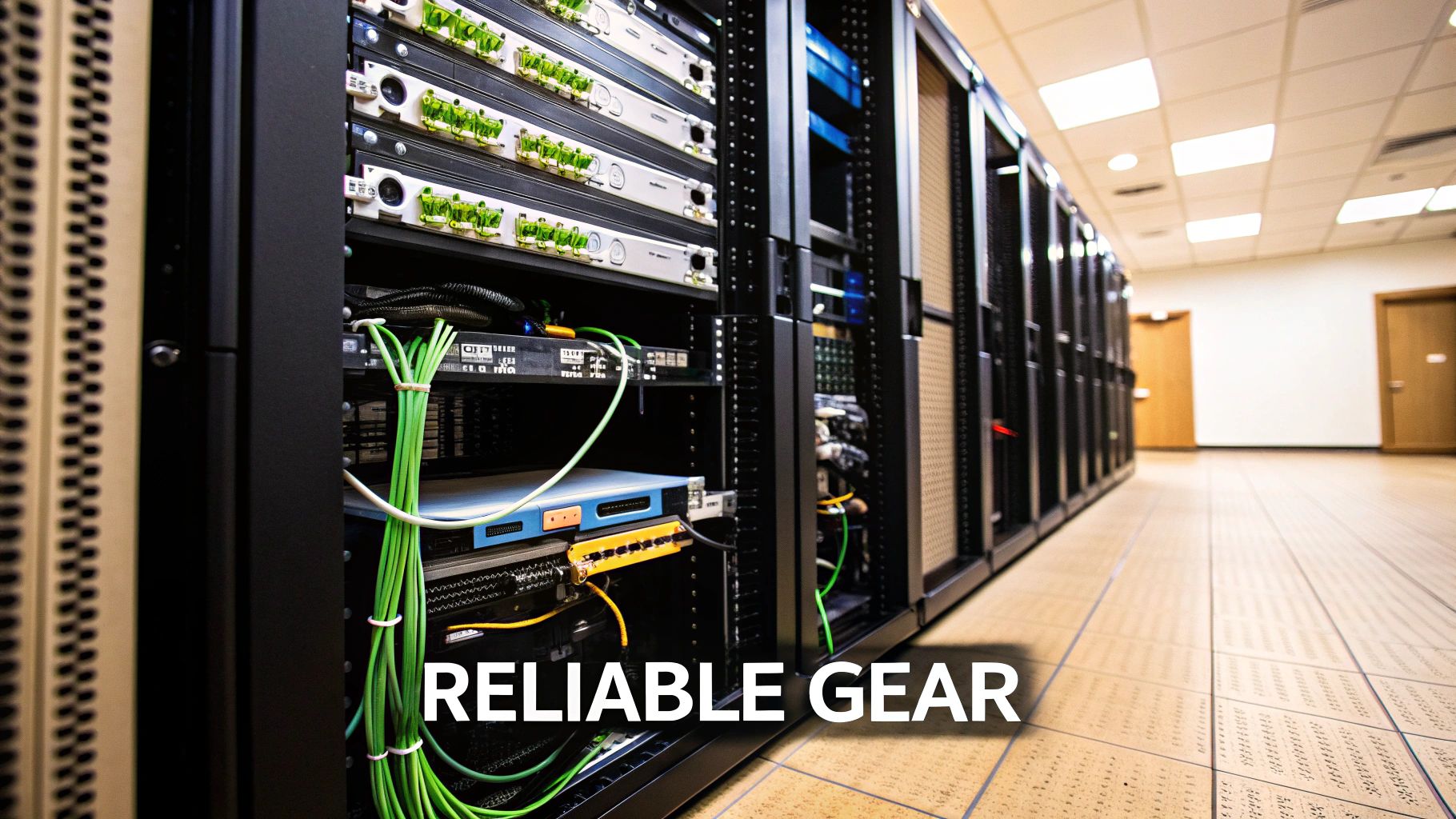
This is one of the most critical decisions you'll make in the entire process. Picking the right partner and equipment for your event wi fi isn't just about renting some gear. You're bringing in a specialist who needs to understand the pressure-cooker environment of a live event.
The hardware that keeps a small office online will absolutely crumble when hundreds of attendees try to connect at once in a packed ballroom. Forget standard routers. You need enterprise-grade equipment built for high-density situations.
We're talking powerful, commercial-grade access points (APs), switches, and controllers designed to handle a massive traffic load without breaking a sweat. The right hardware is what stops bottlenecks from forming and ensures everyone gets a smooth connection, even during the busiest moments. If you want to dive deeper into the tech specs, our guide on the best wireless access points for business is a great place to start.
Vetting Your Wi-Fi Provider
A great provider is so much more than a hardware supplier. They become an extension of your own team, bringing years of on-the-ground experience to the table. The wrong choice? You’ll be left scrambling for help when the connection inevitably drops mid-keynote.
When you're interviewing potential partners, you need to be thorough. Get specific. This is how you'll separate the real pros from the rest. Don't be shy about digging into their past work and internal processes.
Your provider's experience is your best insurance policy. An event is a dynamic, unpredictable environment, and you need a team that has seen it all before and knows how to react under pressure.
Start by asking for case studies from events similar to yours. Then, follow up with some pointed questions about how they actually operate on-site.
- On-Site Support: Will a dedicated technician be on-site for the entire event? What’s their process for tracking down and fixing problems in real-time?
- Experience Level: How many events of this size have they handled in the last year? Ask them to walk you through a challenging situation they faced and how they resolved it.
- Hardware Quality: What specific brands and models of gear do they use? Is their equipment up-to-date (think Wi-Fi 6 or 6E) to handle modern devices?
Selecting the right provider is a skill in itself. For more on this, check out these expert insights on vendor management to help you build a strong partnership.
Why This Industry Is Booming
The demand for solid connectivity is fueling incredible growth. The global Wi-Fi market was valued at around $22.06 billion in 2024 and is projected to skyrocket to $45.12 billion by 2029, growing at a CAGR of 15.4%.
This explosive growth is all about expectations. People now expect fast, stable internet everywhere they go, from an airport lounge to your event venue. It also means more providers are jumping into the market, which makes careful vetting more important than ever.
A true partner won't just show up and plug things in. They'll perform a detailed site survey, design a custom network based on your floor plan, and have a clear game plan for managing everything live. That expertise is what turns a pile of hardware into a seamless service that makes your event better, not a source of frustration.
Executing a Flawless On-Site Deployment
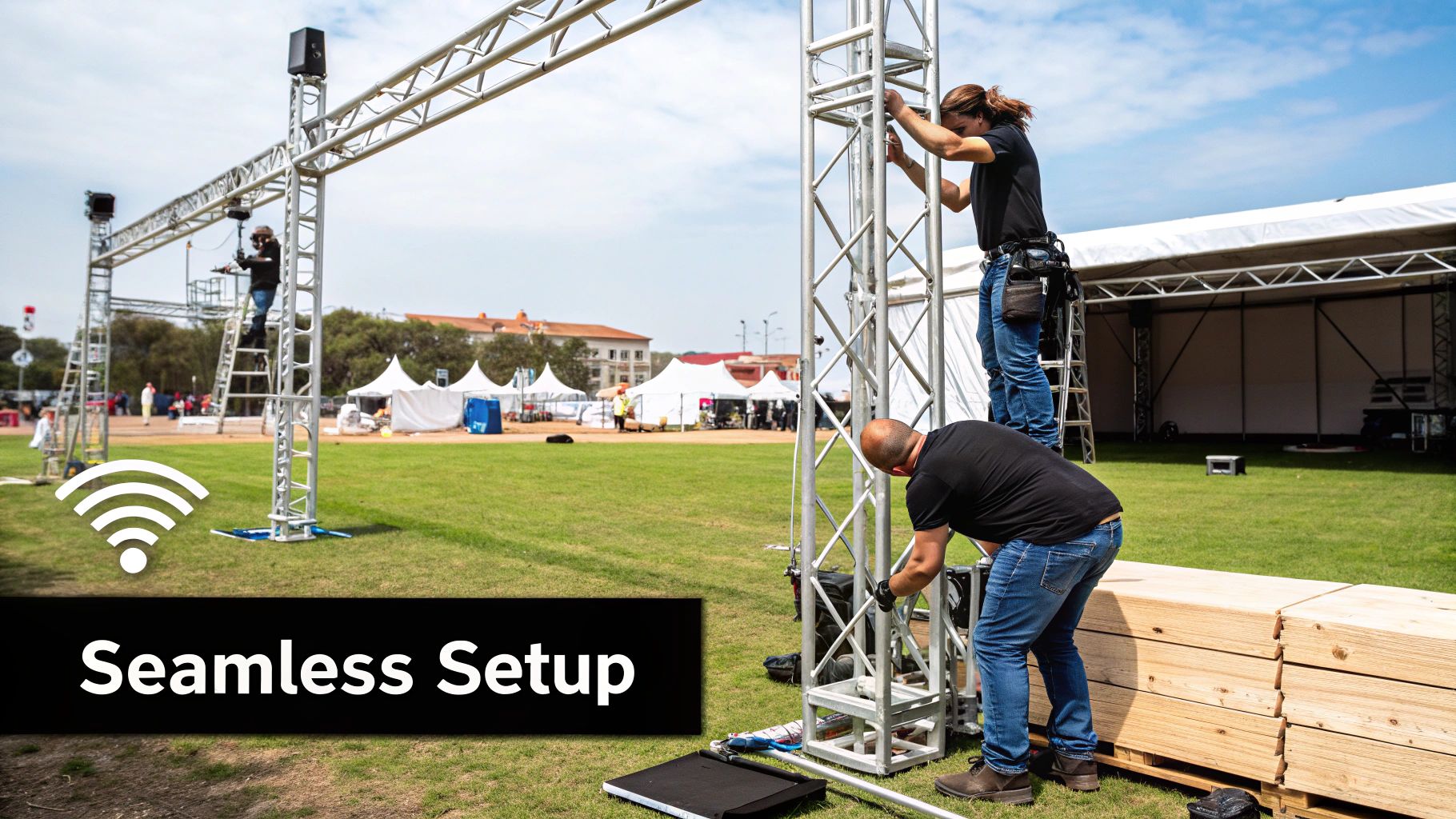
This is it—the moment your careful planning turns into a living, breathing network. The on-site deployment phase is where theory slams into reality, and a solid, battle-tested strategy is what separates a smooth launch from a day of chaos. It’s not just about plugging things in. It’s about building a resilient, segmented, and actively managed digital environment that can handle anything the event throws at it.
A cornerstone of a clean deployment is network segmentation using Service Set Identifiers (SSIDs). Think of SSIDs as separate, named networks broadcast from the same physical equipment. This tactic is your best friend for preventing digital traffic jams and beefing up security.
By creating distinct networks for different groups, you can set unique rules and bandwidth priorities. This ensures a sudden flood of attendees posting to Instagram won't cripple the production team's critical livestream connection.
Structuring Your Networks for Success
A smart network deployment always involves creating several dedicated SSIDs. This strategic separation keeps everything running smoothly and performance high for every single user.
- Attendee Network: This is the big one—your public-facing network. It needs to be simple to access, maybe with a quick captive portal, and robust enough to handle a massive volume of connections for basic browsing and social media.
- Production and Staff Network: This is your crew’s private, password-protected lifeline. It guarantees that point-of-sale terminals, registration kiosks, and streaming gear have the prioritized, rock-solid bandwidth they need to function.
- Exhibitor or Sponsor Network: Your partners often rely on a steady connection for product demos or lead-capture apps. Giving them a dedicated SSID is a fantastic value-add that ensures their tech works flawlessly.
Isolating these groups creates firewalls that contain traffic. The production team's secure network remains completely unaffected by the thousands of devices hopping onto the attendee network, guaranteeing your core operations are bulletproof.
The Non-Negotiable Need for On-Site Tech Support
Here’s a piece of advice I’ve learned the hard way: never, ever run an event without a dedicated technical team on the ground. Even the most perfectly designed event wi fi network can run into curveballs, from surprise RF interference to a single misconfigured device causing headaches for everyone.
A proactive on-site team doesn't just wait for things to break; they hunt for problems before they start. They should be glued to a dashboard, monitoring the network's health in real-time and looking for signs of trouble before a single guest notices a lag.
Having technicians on the floor means you can crush a potential issue in minutes, not hours. They can pinpoint a struggling access point or a bandwidth-hogging device and shut it down before it ever impacts the attendee experience.
This team is your first line of defense. They can run diagnostics, physically reposition an access point, and give immediate help to staff, speakers, or VIPs. Their presence transforms potential catastrophes into minor, invisible fixes, keeping the entire event on track. For anyone wanting to dive deeper into the tools they use, it's worth learning how to measure Wi-Fi signal strength to diagnose coverage gaps on the fly. This kind of active management is the secret to a truly seamless deployment.
Securing Your Network and Attendee Data
In the mad dash to get an event off the ground, it's easy to treat Wi-Fi as a simple "on/off" switch. But an open, unsecured event wi fi network is more than just an oversight—it's a massive liability.
Think of it this way: leaving your network wide open is like leaving the main doors to your venue unlocked overnight. It's a direct invitation for anyone within signal range to connect, potentially exposing your attendees to man-in-the-middle attacks where a hacker can intercept everything they send over the network. That's a risk you just can't afford.
Building Your Digital Defenses
Your first and most fundamental line of defense is strong encryption. I've seen it time and again: a network is set up without a password just to make it "easy" for guests. This is a mistake. Your network absolutely must be configured with WPA2 or WPA3 security. These are the industry standards for a reason—they encrypt the data traveling between a user's device and the access point, making it incredibly difficult for bad actors to eavesdrop.
Next up, you need a captive portal. This is the splash page everyone sees before they can get online. It’s not just for looks; it serves two critical functions. First, it requires users to accept your terms of service. Second, it acts as a gatekeeper, giving you full control over who gets access to your network.
An unprotected Wi-Fi network isn't just a technical misstep; it’s a direct threat to attendee trust. Treat digital security with the same seriousness you'd give to the physical safety of your event.
Setting up a solid captive portal is a key piece of the puzzle. For a more detailed walkthrough, our guide on how to set up guest Wi-Fi breaks down the entire process.
Choosing the Right Way In
How you let people onto your network through the captive portal directly shapes their experience and your security posture. There’s a balancing act here between ease of use, security, and the data you can gather.
Here are the most common methods I see in the field:
- The Simple Password: You provide a single, shared password like "Event2024!" This is a breeze for attendees, but it offers very little real security since the password can be passed around to anyone. It's really only suitable for small, private gatherings where you know everyone.
- Social Media Login: Letting guests sign in with their social accounts is super convenient for them. For you, it can be a goldmine of consent-based demographic data for future marketing. The only real downside is that you’re relying on a third-party platform to handle the authentication.
- Email or Form Fill: Asking for an email address or having attendees fill out a short form is a fantastic way to build your marketing database. It adds a tiny bit of friction to the login process, but the direct-to-attendee data you collect is invaluable for post-event communication.
The right choice really depends on your event. For a huge public conference, a social media or email login strikes a great balance between security and marketing insight. But if you're running a high-stakes corporate summit, you'll probably want to issue unique, single-use access codes to each registered guest. By thinking through your access method, you can create an event wi fi network that’s both welcoming and rock-solid.
Answering Your Top Event Wi-Fi Questions
Even the most experienced planners have questions when it comes to event Wi-Fi. After all, getting it right is non-negotiable. Let’s tackle some of the most common queries we hear from organizers in the trenches.
How Much Bandwidth Do I Really Need?
This is the big one, and the honest answer is: it really depends. The right amount of bandwidth hinges on three things: how many people are coming, how many devices they'll bring, and what they’ll be doing online.
A good rule of thumb is to plan for at least 1.5 devices per person. If your event mainly involves basic web browsing and social media updates, you might get away with 2-3 Mbps per user.
But if you’ve got high-definition live streaming, multiple video conferences, or interactive demos on the agenda, you need to think bigger. For those high-demand activities, you should be aiming for 5-10 Mbps per active user. Anything less, and you're risking frustrating lag and bottlenecks. A professional provider can look at your specific program and calculate a precise number for you.
Can I Just Use the Venue's In-House Wi-Fi?
Relying solely on the venue’s Wi-Fi can be a huge gamble. Most built-in networks are designed for day-to-day, low-density use—think a handful of hotel guests checking email, not hundreds of attendees trying to connect all at once.
These systems often can't handle the massive, concentrated load of a live event. You might find a great signal in the lobby but a complete dead zone on the main stage or in breakout rooms. You absolutely need to have a frank conversation with the venue about their network's true capabilities. For anything important, I'd strongly recommend bringing in a dedicated event Wi-Fi provider to guarantee the performance you need.
Relying on a venue's standard Wi-Fi is one of the biggest risks an event planner can take. It’s rarely built to handle the intense, simultaneous demand of a modern conference, leaving you vulnerable to slowdowns and dead zones when you can least afford them.
What Are the Biggest Wi-Fi Mistakes Planners Make?
By far, the most common mistake is underestimating usage and treating Wi-Fi as an afterthought instead of the critical infrastructure it is. This is what leads to network meltdowns during registration, keynotes, or at the busiest exhibitor booths.
Another major misstep is skipping a professional site survey. This isn't just a "nice-to-have"; it's an essential step to map out where to place access points and identify potential radio frequency (RF) interference that could cripple your network.
Finally, not having a dedicated on-site tech team is a recipe for disaster. These are the experts who monitor the network in real-time and can jump on problems before your attendees even know something is wrong. They're your insurance policy for a smooth event.
At Clouddle Inc, we specialize in designing and deploying rock-solid Wi-Fi networks that can handle the intense demands of any event. Our managed solutions take the guesswork out of connectivity, ensuring your attendees, staff, and sponsors stay seamlessly connected from start to finish. Learn more about our custom event networking solutions.


